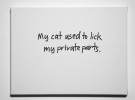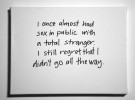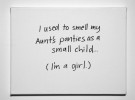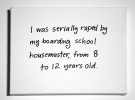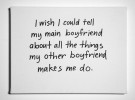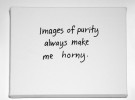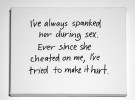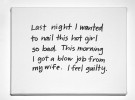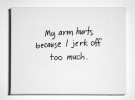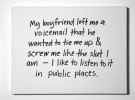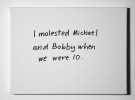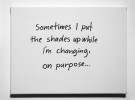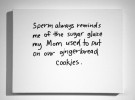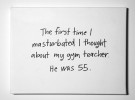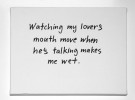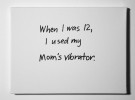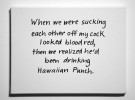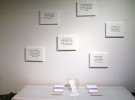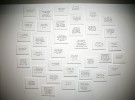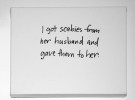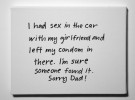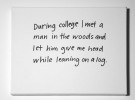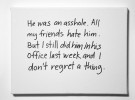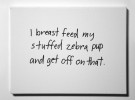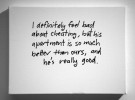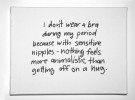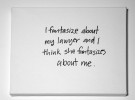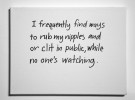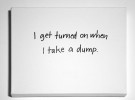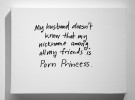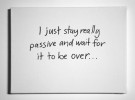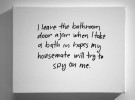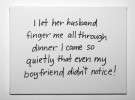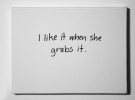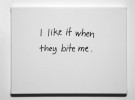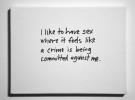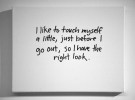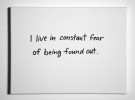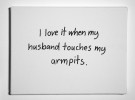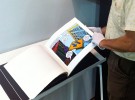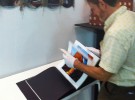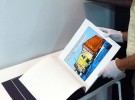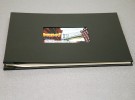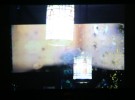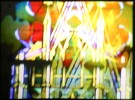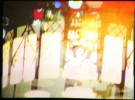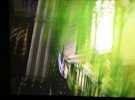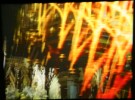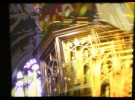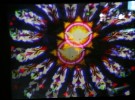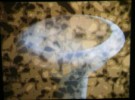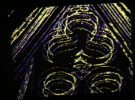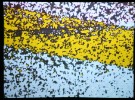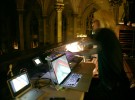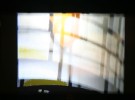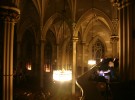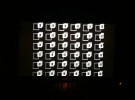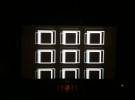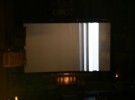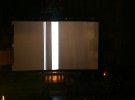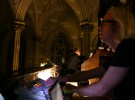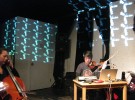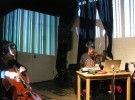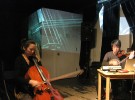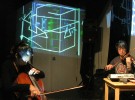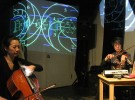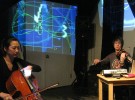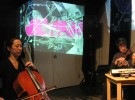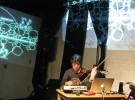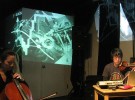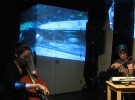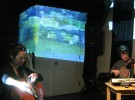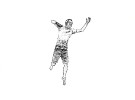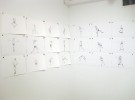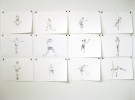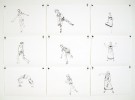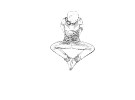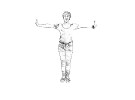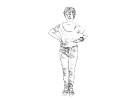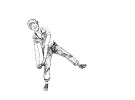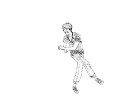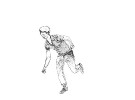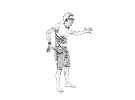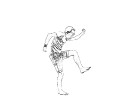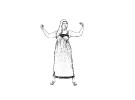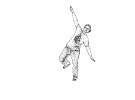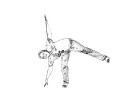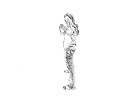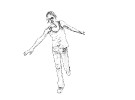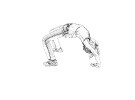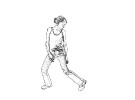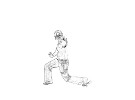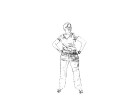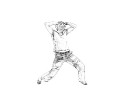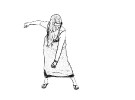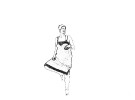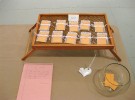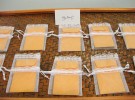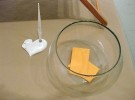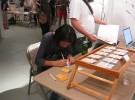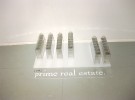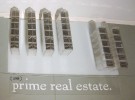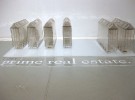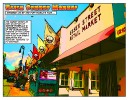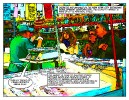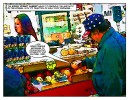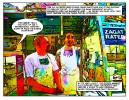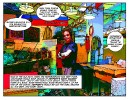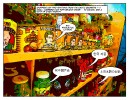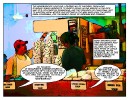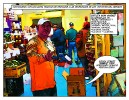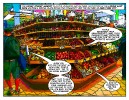Index cards, envelopes, pencils, fish bowl, and archival ink on 9″ x 12″ canvases. Dimensions variable.
Presented at “Tell Me How You REALLY Feel: Diaristic Tendencies”, The Center for Book Arts, New York, NY, 2012; “Operating System”, Sylvia Wald and Po Kim Art Gallery, New York, NY, 2012; and “Index”, Part of the Borimix Festival, CSV Center, New York, NY, 2012
Project Description:
This is a simple participatory artwork where people are invited to write down a sexual secret in pencil, on an index card, put it in a small envelope, and deposit it into an empty fish bowl.
Secrets pulled from the bowl are turned into text paintings on canvas, and a small set of these canvases are displayed above and around the station for writing.
The structure of display is intended to suggest that these shared secrets are like beautiful little fragments or gifts, thus diffusing lurid or unsettling qualities in the massage and encouraging the reader to focus on the humanity of the truth revealed.
Inspiration for the project comes from a number of sources. Many artists have worked with the idea of secrets, and there are numerous websites devoted to sharing anonymous confessions of one sort or another. I have also been intrigued by the jpeg and gif messages left by people for one another on line, often showing some cheesy romantic or sexy image along with a simple text message. (The kind of images that were to be found on My Space, Pinterest or other social interactive sites, and not infrequently covered with dancing sparkles, or animated water reflection effects.) Other sites encourage people to take photos of themselves holding paper signs with messages or promotions, or invite others to write letters or postcards and mail them anonymously to the site, where the most interesting ones will be posted.
The project is also influenced by the many short form writing technologies currently popular, including texting, IM, and Twitter.
Most of the canvases for “My Secret” are messages of only 15 to 25 words or so. Use of the index cards, rather than say a sheet of paper for participants to share secrets on, is intended to encourage this kind of short form writing.
Though the project is largely inspired by internet and digital phenomena, I chose to invite people to participate though old fashioned chirography, in part to suggest the feeling of writing in a diary, and also to evoke the long lost art of the writing of love letters, and notions of secret paramours, and found physical traces of the intimate lives of others.
720p, 29.97fps, 41 minutes and 45 seconds, two channel video installation, projected on a 107″ x 432″ roll of Super White Set paper.
One of the artworks in Paul Clay’s solo show entitled “Sketches and Memories, (synthesized compositions rendered later, upon the artists’ safe return home)”, Part of the Hudson Vally Center for Contemporary Art’s Peekskill Project V, at ArtWestchester’s The Arts Exchange Building, White Plains, NY, 2013.
Through and invitation from Livia Straus, President of HVCCA, and organized by curator Kianga Ellis.
Painters of the Hudson River School traveled to rather remote natural locations where they made sketches, studies and gathered visual memories, but then trekked back to the safety of their homes (and studios) to make the paintings, often combining elements from a variety of different locales into a single synthesized composition. My title for the exhibit is an oblique reference to this practice.
“Sketches and Memories…” is a collection of works addressing the history of Peekskill and White Plains New York, as well as that of the entire Hudson River Valley. The works combine the subjective and personal with larger forces, tracing geology, prehistory, international politics, and global cultural diffusion to tell the story of the region.
Installation Photo:
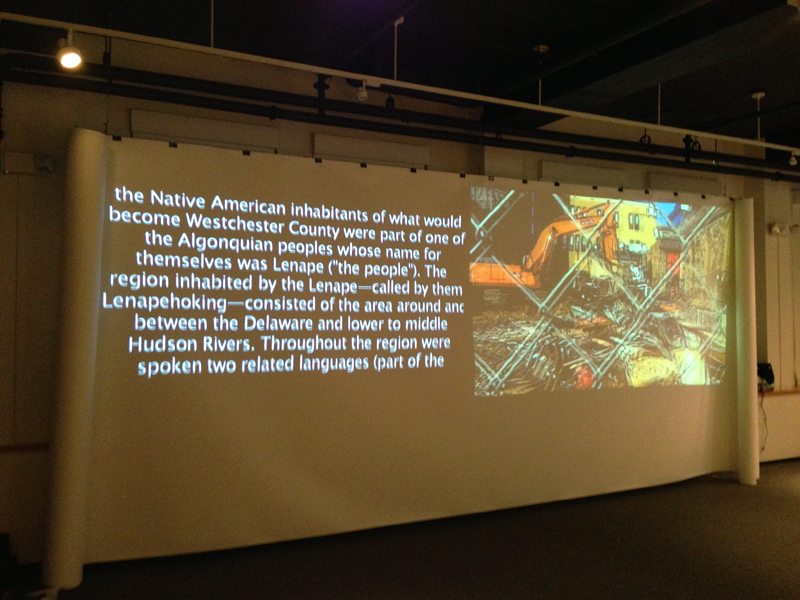
Video Excerpt (4 minutes, 30 seconds):
Project Description:
The video artwork “White Plains Story” incorporates subjective bits of White Plains history from interviews and personal experiences, and also looks at the connection between White Plains and New York City, told in the form of a cartoon, collage or animated comic book, and a long scrolling text. The two channels are projected onto a 9 foot high by 36 foot wide roll of white paper, scrolled up at both left and right ends to create a 22 foot screen.
One video channel projects scrolling text, like one might see at the end of a feature film, but instead of credits, the text tells the history of the White Plains area. It involves three sections or chapters. The first covers the history and language of the Native American Lenape who lived in the region for thousands of years, and the Wappinger confederacy who interacted with European arrivals mostly from the 1600 to 1800’s, along with the Weckquaesgeek, band who lived in what was to become White Plains. The second section covers the history of the Arts Exchange Building, where ArtsWestchester is based, and the third, the history of what European settlers referred to as “the white plains”, from the first non-native settlement in 1683 right up to the present.
A second video channel also projects three sections. The artists trip from New York City up to White Plains, a sit down interview with Kathleen Reckling, Gallery Director of ArtsWestchester about her work and her life growing up in the area, and a driving tour with local resident David Licata through various neighborhoods of the city. This second channel is in the form of a cartoon, shot entirely on an iPhone with the ToonCamera app, to convert the video into the visual look of cartoons, and then edited and enhanced in Final Cut Pro.
Both channels are projected onto a 107 inch by 36 foot long roll of Super White Set or photo background paper, evoking the notion of pages in books, and comic books in particular, while at the same time suggesting scrolls which might contain histories or panoramic landscapes. It also references the technology of acetate film with the ends curled up, and the giant binder clips which hold it up the paper screen spaced along it like sprocket holes.
The two video channels, running concurrently, one historical text, the other lush colored cartoons telling personal stories, cause the viewer to jump back and forth between competing narratives, past and present, suggesting a continuum of reality about the region, which must be parsed and filtered to make sense of. All of the disperate competing truths coming together to suggest one possible White Plains Story.
720p, 29.97fps, 6 minute 45 seconds, single channel, silent video work.
Presented in the exhibit “In Kritieke Staat” (In a Critical State), at Het KunstenLab (The Art lab), Deventer, Netherlands.
Curated by Marit Otto & Patrick Mangnus
Project Description:
Created by the artist doing screen captures of going through his own email, and responding to requests to take action on behalf of different causes. The video increases in speed over time suggesting the urgency of countering negative forces in the world, and fades out at the end, with the suggestion that the need to take action is ongoing, and perhaps never-ending. The viewer is left with the task of deciding whether efforts to change the world via electronic action at a distance are vital or hopeless, naive or heroic, or simply a necessary part of everyday life.
Video Excerpt (One minute, silent):
13″x19″ Leather bound 18 page hand assembled book, presented in the group exhibit “The Un(Framed) Photograph” focusing on how the art of photography, the photographic process, and related media are used to convey content, form, text, and image, within a broader context of book arts practices. Curated by Alexander Campos and Doug Beube, at The Center for Book Arts, New York City, July 2011.
The work is intended to explore the Brooklyn neighborhood of Dumbo, and is part of a series of works using this same material in different formats including video projection and large format prints on paper and canvas. The following are some installation images.
Project Description:
This work takes 30 Washington Street as its starting point, to explore Dumbo’s unique history, and its architectural and sociological development. The artwork, in a form similar to the comic book, take inspiration from the factories built along the East River waterfront.
Dumbo is a place of outsized architecture. Everything is at the scale of elephants or super heroes. In addition to its rich history, it is currently the site of some of the most intense gentrification in New York City. In Dumbo Comic Book the neighborhood and the buildings themselves are characterized through the visual language of the comic book, in order to provoke thought on issues of urban planning, quality of life, and the visual impact of the street level built environment. The project acknowledges the scale of the area and the special place which architecture and development holds here.
Methods:
This work started from 12 megapixel digital stills shot on the streets of Dumbo. These images are then individually run through a variety of different types of desktop printing software and extensively reworked and elaborated, with a focus on the use of algorithms for edge detection, and chromatic separation and simplification, resulting in a set of “Technicolor” schemed cartoon prints, capturing architectural detail, and the street level build environment.
Text has been added by doing a Google search for the word “Dumbo” and culling bits of text and actual quotes from the search results. Part of the byproduct of this method is that elements of text treating the 1941 Walt Disney Animated feature by the same name also make their way into the work, serendipitously adding to critique of issues within the neighborhood.
Working with the form of the comic, this project attempts to provoke thought on issues of urban planing, quality of life, and visual impact of the street level built environment.
For details on other work from this series see:
http://www.paulclay.net/2009/dumbo-comic-print-work-2009/
and:
http://www.paulclay.net/2006/dumbo-comic-2006/
Live video projection working with a series of different musicians. Presented at St. Patricks Old Cathedral, New York, City. This was part of “FlashLight” an event put together by Nuit Blanche New York, in conjunction with the New Museum’s Festival of Ideas for the New City, May 7th, 2011
Project Description:
This was a kind of visual jazz style improvisation in which I pre shot content at the Cathedral, and then mixed it live along with video from a live camera, to create a set of moving images in time to the music, and evoking qualities in each of the musical compositions. The visuals were projected on a huge screen stretching across the the altar area. Content included close ups of stained glass, and of architectural details of the church itself. The live video mix was accompaniment to the following music:
Aaron Siegel – Common Tones
One of the fundamental elements of musical counterpoint is the idea that movement from one chord to another is facilitated by the presence of some of the same material in both chords. Common Tones explores this idea using a limited amount of information deployed slowly over the course a performance. The structured improvisation will be performed by Basilica Music Director, Jared Lamenzo.
Matt Marble – Way Up in the Middle of the Air
Way up is a work of scored improvisation for organ + ensemble (trb, bsn, acc, 2 b., & prepared synth). Inspired by Ezekiel’s fantastic vision in the Old Testament, wherein he sees 4-headed cherubs tied to crystalline gyroscopes, all supporting the glass throne of a divine chariot… way up is a sonic meditation on the vehicle of ascension. Simply put: Dream on & Levitate.
Pilottone – Flash:Remix
Pilottone will present a performance and intervention in which the group will stage and remix… as they repurpose sounds collected earlier in the evening during the Festival of Ideas.
Collaboration with Hahn Rowe, 2010
Live, dual screen video projection onto architectural surfaces behind the musicians. Presented at The Stone, New York City, With Hahn Rowe and Ha-Yang Kim.
Project Description:
I worked with the idea of music as mathematics. This was a kind of visual jazz style improvisation in which I brought in a limited amount of pre shot content, and then mixed it live along with video from two live cameras, to create a set of moving images in time to the music, and evoking qualities in each of the movements of the musical composition. Inspired by the fact that Han is of Korean descent, I also used images of driving through the Korean countryside for one of the movements.
Twenty one 13″ x19″ Digital drawings, (three each) of the seven other artists in The Elizabeth Foundation for the Arts inaugural “Studio Residency for New York City Arts Workers”. The drawings are made directly from digital photographs, using algorithms associated with edge detection. Presented during the residency, EFA Project Space, New York City.
Project Description:
The title makes reference to the classic 1954 Japanese film by Akira Kurosawa. Seven Artists acknowledges the difficult place artists occupy in contemporary Western society, where there are veritable armies of professionally trained artists exiting art schools every year, yet there is little hope that most can make a living from their chosen profession. The situation is further complicated by the fact that artists are frequently used by real estate developers to rejuvenate blighted neighborhoods, only to be evicted after the goal has been accomplished.
New York City Arts workers take on an even more difficult task, devoting a portion of their precious time, energy, and networking abilities, to assist artists other than themselves. I wanted to make an artwork about the residency and the fact that there were seven artists (not including myself) created the opportunity for this frame.
Superheros have been in the zeitgeist for some years now, and for this project I asked the artists if I could photograph them in movements suggesting a benevolent fictional character with superhuman powers. All the artists were game, though each interpreted the request in a different way. Some struck classic poses while others simply moved like gymnasts or athletes.
In Seven Samurai the character Kambei notes at the end of the film: “Again we are defeated. The farmers have won. Not us.” Yet with help from the The Elizabeth Foundation for the Arts, the artists may succeed, and save the world after all.
Note cards, miniature manila envelopes, Lace gift bags, decorative pen, fish bowl, folding table stand, desk, and chair. Dimensions variable.
Created at, and presented during The Elizabeth Foundation for the Arts “Studio Residency for New York City Arts Workers”, New York City.
Project Description:
This is a simple interactive artwork where people are welcomed to write down a sexual secret on a small folding card, (resembling a mass produced gift card), put it in a small manilla envelope, and deposit it into an empty fish bowl. At intervals the secrets are pulled from the bowl and placed in miniature lace giftbags, where they are displayed on a small folding table stand. These can be opened and read by visitors, who then put them back for the next viewer to encounter.
The structure of display is intended to suggest that these shared secrets are like beautiful little gifts, thus diffusing lurid or unsettling qualities in the massage and encouraging the reader to focus on the humanity of the truth revealed.
Plastic retail display parts, found and altered plexiglass sign, and Plexiglass base. 9″h x 31″w x 24″d
Created at, and presented during The Elizabeth Foundation for the Arts “Studio Residency for New York City Arts Workersâ€, New York City.
Project Description:
This is a sculpture made of objects found mostly around the vicinity of EFA. The theme is self explanatory, though the visual surface is intended to confound a quick political reading, and to create questions in the mind of the viewer. The modified plexiglass sign from which the title is drawn, is cut from a section of a larger plexiglass sign found in the garbage on the street. Given the number of artists in the neighborhood, it may even have been part of some previous artist’s discarded project. The shinny artificial quality of the materials suggests the supply chain in modern industrial manufacturing, and the waste as these materials are used to create things that are now not even needed, as their completely artificial value has now plummeted.
Representation, a Chronicle of the Essex Street Market
Paul Clay, 2009
A series of 44″x66″ digital prints on archival 100% cotton paper, using historical research, oral history, and the representational form of a comic book, to chart the sociocultural development of the Lower East Side through the story of the Essex Street Market.
A selection of the pieces will be on display, starting with the opening reception Saturday, December 12th, from 5pm-7pm in the North End of the Essex Market, 120 Essex St., New York City, and the exhibit will run through January 2010.
This project is made possible, in part, with public funds from the Manhattan Community Arts Fund, supported by the New York City Department of Cultural Affairs and administered by the Lower Manhattan Cultural Council, and with generous support from The New York City Economic Development Corporation and the Department of Small Business Services.
Project Description:
The comics are made from photos of actual people who work in and frequent the market,and include text in multiple languages, with both historical data, and information from oral histories, capturing a snapshot of a vibrant and volatile historical moment.
The Essex Street Market is a long standing center of everyday culture in the Lower East Side. It is unique on many fronts: for the products available, the atmosphere of the place, its inherent support for rapidly disappearing craft practices, and its tradition of multi generational handing-down of family business lore. Also, by its very layout, it supports high job density and the preservation of the aesthetic of the bodega, with its tradition of daily food purchase and simultaneous exchange of neighborhood, community and cultural information. The Essex Street Market is a vital business and cultural institution in the Lower East Side and this artwork highlights its special place within the community and the culture of New York City.
The neighborhood contains a diverse mix of cultures, from long standing Jewish residents to Puerto Ricans having arrived in the 60’s and 70’s, followed by Dominicans, and the expansion of Chinatown, not to mention local artists who settled in the area back when the rents were affordable, and the recent influx of Japanese and Koreans. Rapid gentrification over the recent past has created huge cultural flux and a wide range of levels of income among residents.
